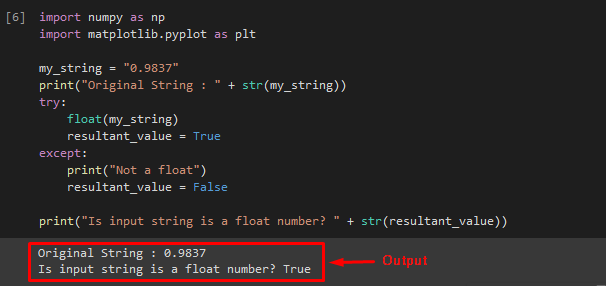Python Check if a String is a Float
A string is any collection of characters that is surrounded by single or double-quotes marks and interpreted literally by a script. More specifically, a string that involves several lines is called a multiline string. The floating points are one of the most common built-in numeric data types having decimal points. Changing the integral value is quite easy. However, the transformation of the floating number is much more complicated.
This guide will provide a way to check if a string is float or not in Python.
How to Check if a String is a Float in Python?
To check if a string is a float in Python, the below-listed methods are used:
Method 1: Check if a String is a Float in Python Utilizing “float()” Method
To check if a Python string is a float or not, the “float()” is used. It can transform the provided string to a float number. Moreover, it can fail to represent that the specified string is not a valid number.
Example
First, import the “numpy” library as an “np. Then, import the “matplotlib.pyplot” as a “plt” to manage some numeric values and manage graph:
import matplotlib.pyplot as plt
Now, create a string variable and initialize with the floating number:
Next, print the above-initialized string:
Then, use the try-except block to check if the provided string is float or not. For this purpose, we have invoked the “float()” method and passed a string as an argument. After that, we created a variable which used to store the results. If a string is not a float number then it will print the specified message”
float(my_string)
resultant_value = True
except:
print("Not a float")
resultant_value = False
print("Is input string is a float number? " + str(resultant_value))
The value “true” as output indicates that the provided string is a float value:

Method 2: Check if a String is a Float in Python Utilizing “replace()” and “isdigit()” Methods
Another method to check if a string is a floating number or not in Python, the “replace()” and “isdigit()” method. The “replace()” method provides all instances of a substring by another. However, the “isdigit()” method is used to verify the data type of the variables.
Example
Call the “replace()” method with the required arguments. Then, use the “isdigit()” method. To store the results, declare a “resultant_value” variable:
Use the “print()” built-in function to display the results of provided variable:
Output

That’s all! You have learned different ways to check whether the provided string is a float in Python.
Conclusion
To check if a string is float or not in Python, the “float()” method, the “replace()” method, and the “isdigit()” method can be used. All methods are Python’s built-in methods. In this guide, we have provided all possible ways to check if a string is float or not in Python.
Source: linuxhint.com
